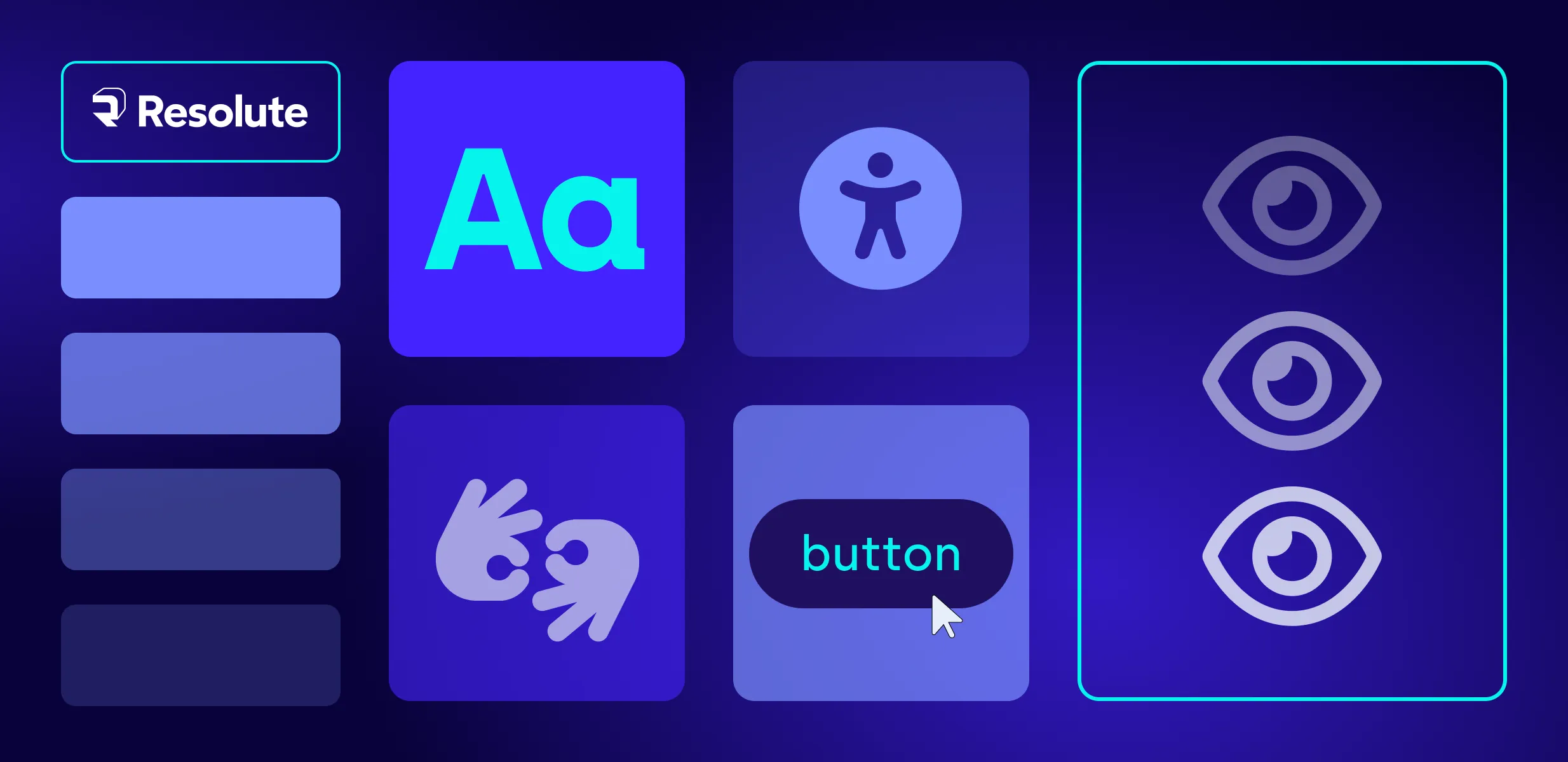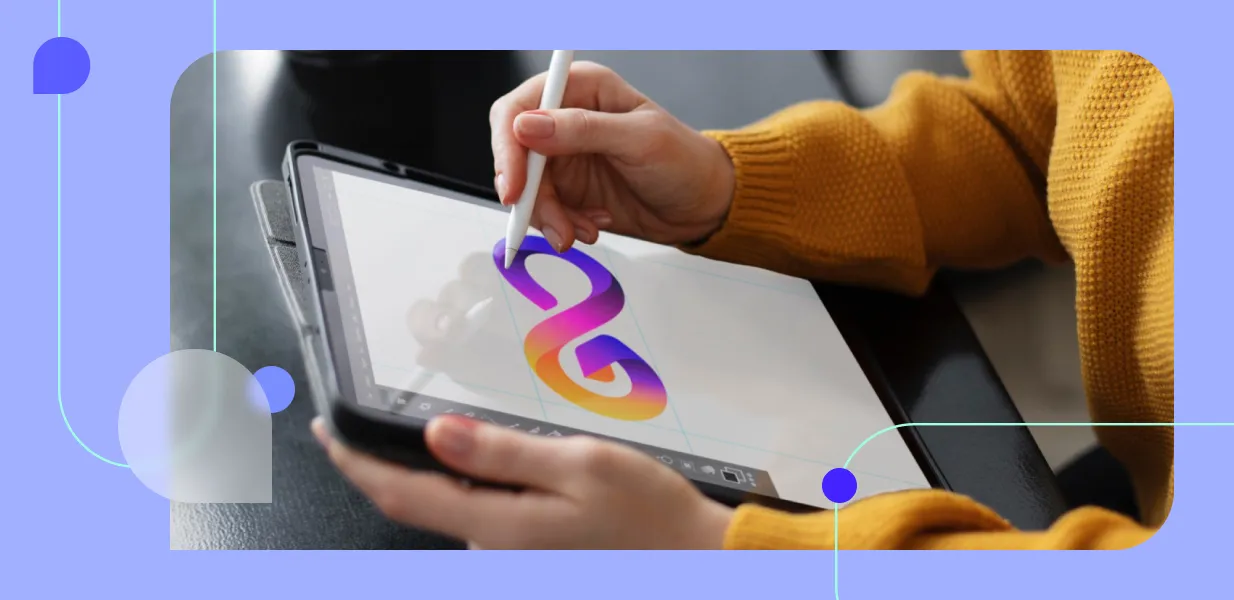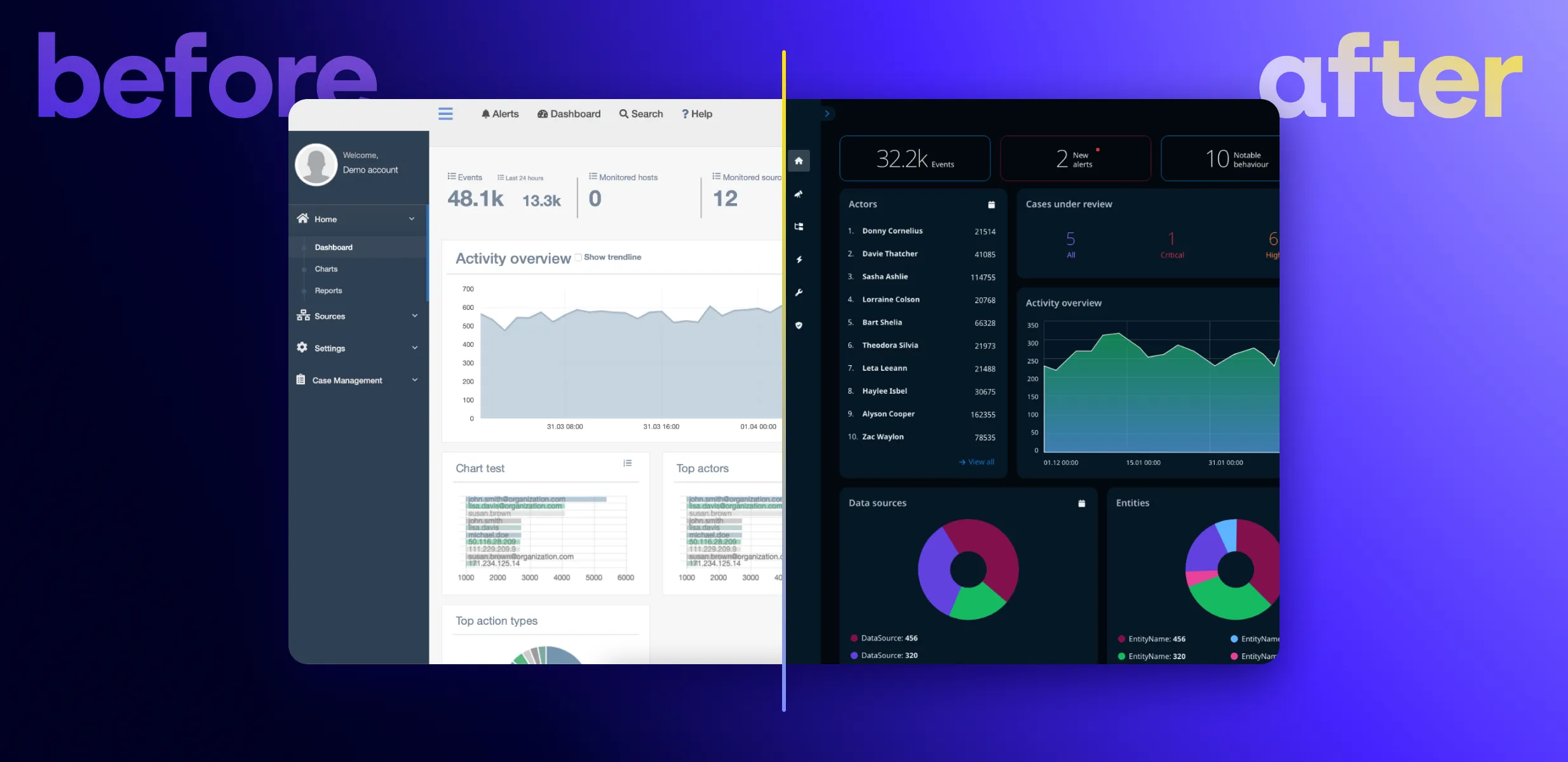
UX design process explained in 6 steps
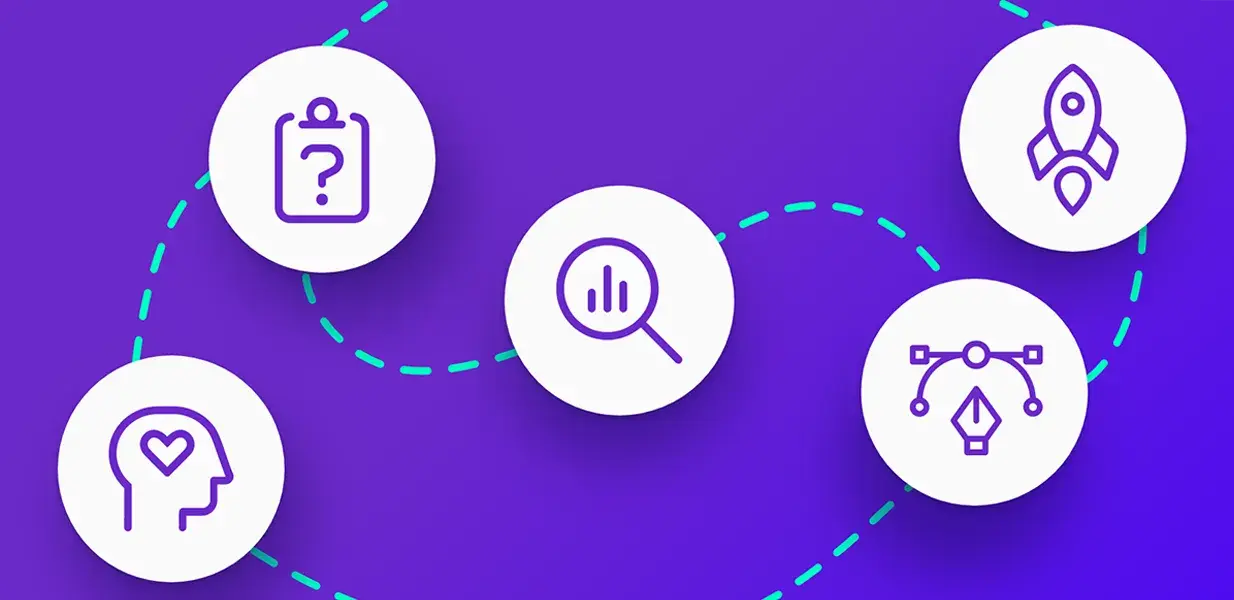
For many businesses, the user experience design process is at the core of creating useful, effective and loved products.
In order to understand how the UX design process brings value to both businesses and users, let’s have a general overview of what UX design is and how a product development team might follow the standard UX design process or customize it to fit the unique business goals and user personas needs.
What is UX design?
The user experience design process is part of the product design and development and focuses on creating useful, efficient and effective products by making them meaningful, relevant and pleasant to interact with for the users.
The encompassing experience of being made aware of the brand, being marketed a product, trying the product, buying and using it, communicating with support, upgrading with new features and so on is the user experience and none of its parts can be left to chance - they are all subject to the UX design process.
UX ≠ UI
Sometimes UX design can be equated with UI design especially when used by non-professionals. User Experience (UX) design is the more general of the two and we may argue that it contains User Interface (UI) design. UI design aims specifically at creating a visual (or audio) representation of the interface that the users interact with.
UX design = research, iteration, constant improvement
To sum up, UX design aims to create useful and relevant products via an iterative process. You could say there is never a final product in the UX design process, as it constantly tries to improve the way a user interacts with the interface.
Why is UX design important?
Ever since the UX design process was introduced, it has helped elevate products and services by taking into account the user personas needs, goals and pain points. This has resulted in smaller learning curves and increased value for the target audience of the product or service.
So why is ux design important? From business point of view, the UX design process has led to decreased risk, faster adoption and greater customer loyalty for new or existing products.
What does the UX process look like?
In the field of product design and even UX design there is a lot of terminology that describes the UX process in various ways and from different aspects. From Human Centered Design (HCD) to Design thinking, The Double Diamond design model and Design sprints, we have different methodologies that can be applied when designing a product with the user experience in mind.
UX design processes are not the same
Although there are ISO standards that prescribe how HCD should be performed (ISO 9241-210:2019(en) Ergonomics of human-system interaction — Part 210: Human-centred design for interactive systems), it is also true that UX designers and organizations cannot always apply the same UX design process and modify it when the product or other circumstances require it.
In general, the UX design process is iterative and non-linear, includes a lot of research and analyzing user needs and pain points, ideating solutions and testing them until the result fits both the user and business goals.
The UX design phases
While Human Centered Design is a general approach to designing any user interface as human interface, Design thinking sets a framework for understanding the user personas and the problems they face, ideating solutions and analyzing how well the solutions perform.
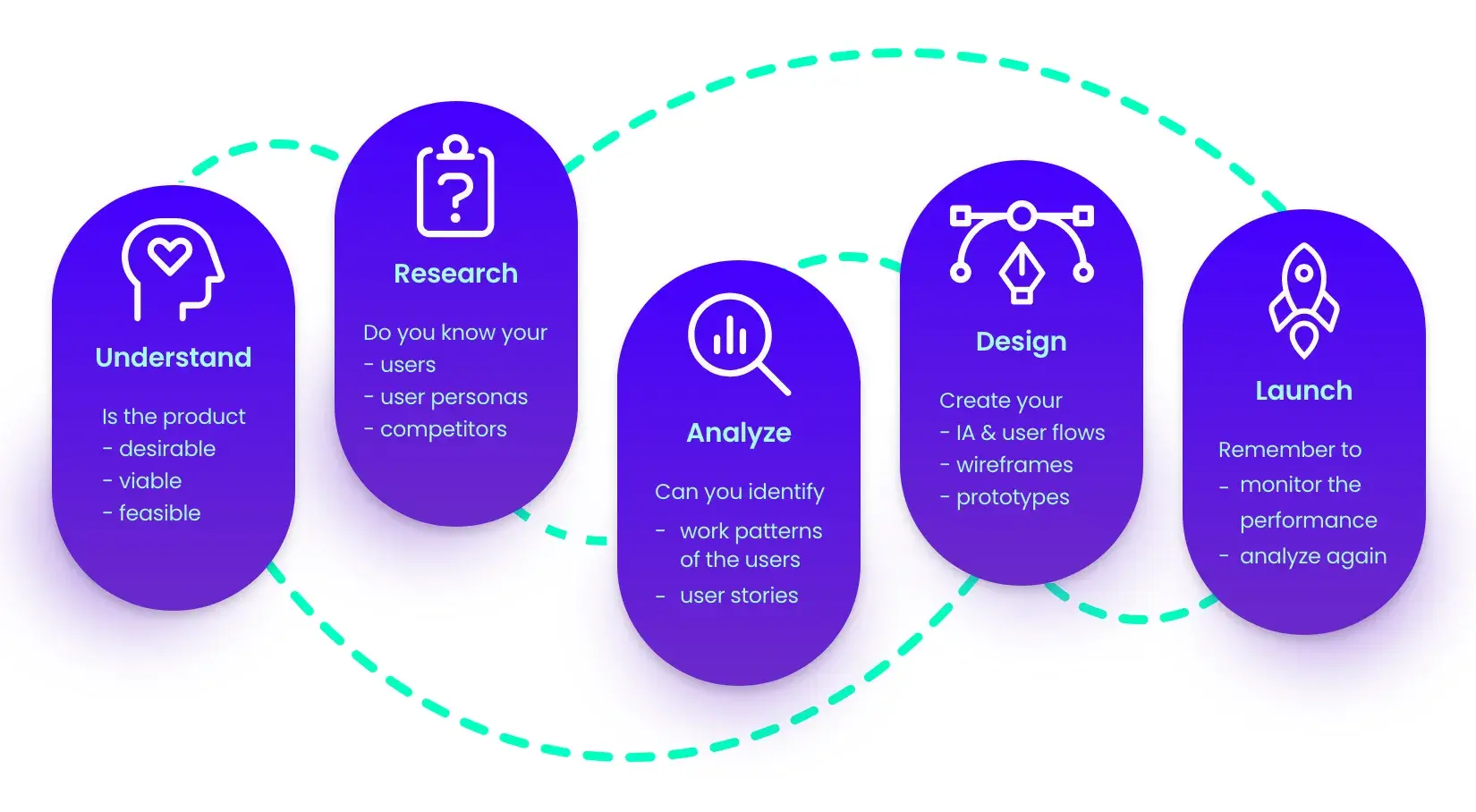
Based on the Design thinking methodology, we can outline the following key phases in the UX design process:
Design phase 1: Understand
The UX design process starts with the so called product definition phase. This stage is fundamental for the rest of the design process. During this first phase, the product design team would try to understand the problem they are trying to solve, come up with very general ideas about how to solve it and form the value proposition of the product or feature. There are several questions that need to be answered during this phase:
Is the product desirable?
In order to check if your product is desirable, it has to solve a real life problem and offer a unique value proposition or at least one that is better than your competitors’ solutions.
At this point you can perform quantitative research or conduct user interviews and focus groups to analyze the behavior and thinking of your target audience.
Is the product viable?
The product viability is judged from the business point of view and assesses if the product will actually be good for the business. Even the most unique and brilliant product concept that solves the most important user pain points is not viable if it costs too much to develop or has no profitability after release.
Is the product feasible?
Companies usually operate within limits when it comes to technology, time-to-market, human resources and finance. A feasible product is one that the business already has enough resources to produce without great risk.
If the value proposition so far ticks all the boxes, the product definition phase is complete and the team can move on to conduct in-depth research.
Design phase 2: Research
The Research phase allows UX designers and researchers to collect all the necessary information about the target audience of the product and the competitors on the market.
User research and user personas
The user research helps to produce a user persona, or several of them, and to get good understanding of their environment, demographics and behaviors.
At this point it is too early to collect user feedback but a UX designer or researcher can resort to quantitative data to figure out patterns in the user behavior and identify potential areas for improvement. One way of collecting quantitative data is if you have access to analytics reports, which may be tricky if you don’t have a live product yet.
An alternative user research method is to send out questionnaires and surveys either online or live in order to collect data. While analyzing questionnaires with open-ended questions is timely and tricky, using closed-ended questions and scales (1-10, not likely - very likely) normally produces meaningful data that can be incorporated in the ux research.
To complement the quantitative data, UX designers and researchers can also perform focus groups and interviews with representatives of their target audience. This quantitative data is especially useful when creating the user persona and user stories and user journey maps later on.
Competitors research
There is hardly any product that has no competitors available on the market, and that is invaluable for product research.
Researching the way competitors have solved (or decided not to solve) a similar or identical problem can generate valuable insights for your product design process. At the end of the day, you will know how to leverage your solution and offer improved experience to your customers.
Once the UX research is concluded, it is time to analyze the data that has been collected.
Design phase 3: Analyze
The data gathered throughout the research phase should now help you generate insights about your users and your product.
User persona(s)
Using the data from user interviews, focus groups, analytics questionnaires and surveys, the UX designers or researchers start figuring out patterns that form the user persona - a generic representation of the typical users of the product.
The persona is a mechanism that keeps the design team focused on the user and their pain points, goals and needs. The persona will usually have a name, occupation, hobbies and so on. This information makes the persona lifelike and helps the UX designers and the product team empathize with the persona more easily. In that way a user persona becomes shorthand for a user profile or segment and makes communication and user-centered ideation a lot more streamlined.
User stories
Once the team gets to know the user persona well, they can create user stories that describe how the persona interacts with the interface in order to achieve a certain goal.
The standard format of a user story states who the user is, what they want to do and why do they want to do it. For example:
As a system admin, I want to be able to configure which screens are available for each user type, so that I am sure that each user has access only to content relevant for them.
When the data is analyzed and meaningful insights have been recorded, the ux process can continue with the design.
Design phase 4: Design
During the design stage the UX designers would produce all the design deliverables that the end user will actually interact with and which will have the greatest impact on the user experience.
Information architecture
In order to build any properly functioning interface, the information architecture needs to be put in place first. The information architecture represents all pages or features in a software and how they are related to each other. It can be represented as a schematic chart of linked boxes with or without hierarchical structure.
User flows
Once the basic structure of the interface is clear, it is easy to define the path a user should take to complete a task. User flows describe each touchpoint the user has with the interface while achieving their goal. At this point, high visual fidelity or aesthetics are not crucial, so user flows can be quickly sketched on paper or created out of sticky notes, so that they can be easily altered during ideation sessions.
Wireframes
The UX designer will use generic terms in the user flows, such as CTA for a Sign up button, and still be able to get the message across. To link the process described by the user flow to the real interface, the UX designer would sketch out wireframes in different levels of fidelity that help the product design team visualize the layout and components that make up each screen in the interface.
Additionally, the UX wireframes can be linked to represent different user flows (wireflows). In that way, it is easier for the stakeholders to visualize and understand both the interface and the process of completing a certain task.
Prototypes
Any UX designer would tell you it is the high fidelity prototype that is most desired by everyone. Prototypes, especially when they are realistic representations of the interface, are invaluable as they spare companies time and money on developing an interface that has visual and experience flaws.
In practice, you can validate even a low and mid fidelity prototype with stakeholders or even with users. User testing is great for creating efficiencies in the UX design process as it can help you figure out what works well and what does not even before development has started.
After the final design deliverables have been created and validated, it is time for product launch.
Design phase 5: Launch
Once the product is launched, the work is not done yet. The UX designer or visual designer can use different methods to monitor the performance, quality of the front end implementation and the behavior of the users.
It is often the UX designer’s job to work closely with the development team during before the final launch so that it is certain that the product will meet both technical, visual and design specifications.
However, there is always space for improvement, especially if the product team has identified new trends through market research or the UX designers have noted opportunities for improving the user experience.
Design phase 6: Analyze (again)
The world around us changes all the time, people’s needs and goals evolve, technology gets outdated fast. That is why the UX design process continues with analyzing the existing product and identifying what performs well, what does not, which user needs are not addressed yet.
At this phase UX designers and researchers can perform user testing on the live product. Usability testing is one of the core ux design principles for great end results and it is done with real users to get probably the most relevant feedback and insights.
Get a trusted partner for your UX needs
At Resolute Software, we boast a team of highly experienced UX/UI experts who have successfully handled 100+ collaborations with clients worldwide.
Is there anything we can do for your brand’s UX? There’s no challenging task for us. Our expert design team would be happy to assist with the UX strategy, product and user research, and UX/UI design.
Get in touch with us and let’s discuss your UX strategy.
FAQs
For a start, put your user in the center, think about their needs, goals and pain points. When you come up with a solution, ask is this solution desirable, viable and feasible. If yes, move on with the product research.
The UX lifecycle a synonym for the UX design process. It is an iterative process where phases can be repeated as needed in order to produce a relevant and desirable solution.
The first step of the design process can vary depending on the methodology and the businesses specific needs and circumstances. In general, product design teams would start the UX design process by trying to empathise with or understand their users, what needs, goals and pain points they have.



